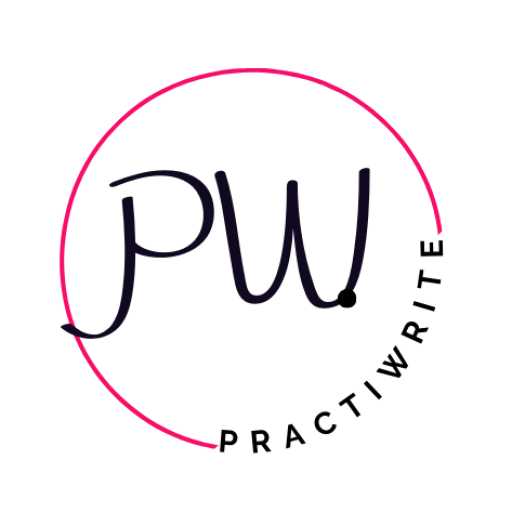If you can’t show up in a local Google search when someone types “dental implants near me,” you’re not even in the running.
And with AI assistants now influencing what shows up in search results, just having a website isn’t enough. Your practice needs to be everywhere your patients are looking, and that means tightening up your SEO and local visibility fast.
This isn’t about chasing algorithms. It’s about giving Google (and now AI) the exact proof they need to confidently recommend you, not the practice down the street.
Dental practices that get found have three things in place:
- Clean local listings
- Fresh reviews
- And structured content that answers what patients are really asking
Miss any of those, and you’re invisible.
I’m not here to impress you as an SEO agency.
I’m here to give you SEO/GEO strategies for dental implant practices to get your phone ringing.
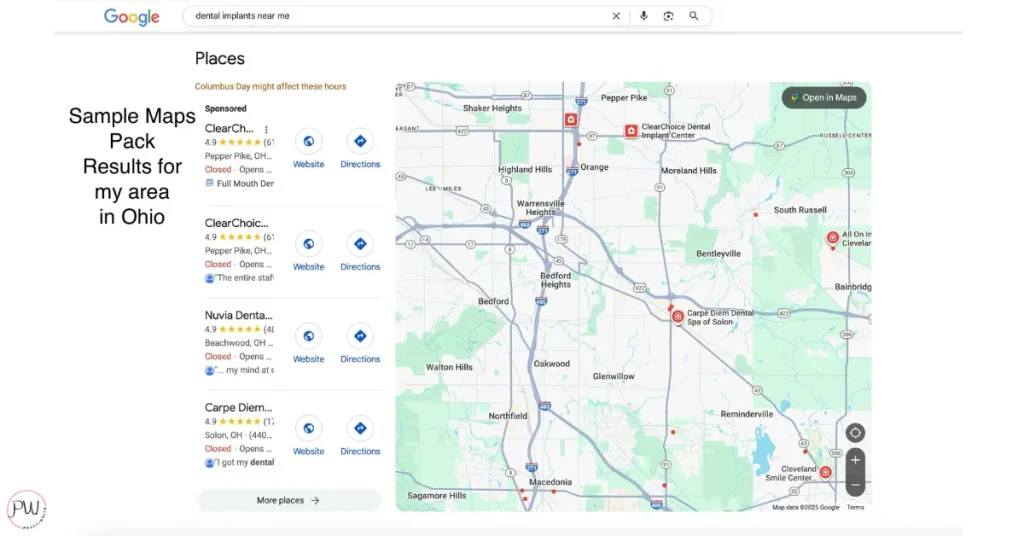
Table of Contents
SEO for Dental Implant Practices: When to Use Traditional SEO vs. GEO for Local Growth
Let’s skip the theory. If your dental implant practice isn’t showing up in the top 3 local results (the Map Pack) you’re losing high-ticket patients daily.
And it’s not your website holding you back. It’s the basics: your Google Business Profile (GBP), your online reviews, and how clearly your business information shows up across the web.
Forget the long-form pages for now. Focus on what actually moves the needle:
- 97% of people learn more about a local business online than anywhere else (BrightLocal, 2024).
- 88% of consumers who do a local search on their smartphone visit or call a business within a day (Think with Google).
- And yes, practices with complete, up-to-date GBPs get 7x more clicks than those without (Whitespark, 2024).
Step One: Skip the Glossy Website Edits. Fix the Stuff That Patients and Google Actually See.
Start where Google (and your potential patients) start: your local presence.
Here’s your checklist:
- Google Business Profile tune-up
- Set your primary category to “Dental Implant Provider” or “Cosmetic Dentist.”
- Fill in every single field—hours, services, address, phone, website.
- Add 3–5 high-quality, recent photos (inside + outside your office).
- Set your primary category to “Dental Implant Provider” or “Cosmetic Dentist.”
- NAP Consistency Check
- Make sure your Name, Address, Phone Number are identical across:
- Google
- Apple Maps
- Yelp
- Bing Places
- Healthgrades
- Your state dental board site
- Google
- Use a free tool like Moz Local or BrightLocal’s NAP Audit to find mismatches.
- Make sure your Name, Address, Phone Number are identical across:
- Show Your Pricing + Answer Real Questions
- Add a simple pricing range (e.g., “Implants start at $2,000”) directly to your GBP or your site’s implants page.
- Post an FAQ section answering the top 5 questions patients ask:
- Am I a candidate?
- How long does it take?
- Does it hurt?
- What does it cost?
- Is financing available?
- Am I a candidate?
- Add a simple pricing range (e.g., “Implants start at $2,000”) directly to your GBP or your site’s implants page.
- Review Strategy That Actually Works
- Ask every patient who gets an implant consult or procedure.
- Use a HIPAA-compliant tool like Birdeye or Doctible to automate requests.
- Respond to all reviews within 48 hours using non-medical language.
- Ask every patient who gets an implant consult or procedure.
Do this, and you’ll typically see results (mentions in search, map pack visibility, even AI answers) in 30–45 days. We’ve seen this shift happen in as little as 3 weeks for dental clients who fixed their GBP, added patient-friendly FAQs, and cleaned up NAP data.
Take a screenshot of “dental implants near me” today at 8:15 a.m. Re-check it weekly. That’s your tracking system.
-Nicole Kolesar, Founder & CEO of Practiwrite
Days 1–45: Build the Foundation That Google (and AI) Trust
This is where most practices get stuck. Not because they’re doing something wrong, but because they’re skipping the boring stuff that actually makes the difference.
If your Name, Address, and Phone number (NAP) aren’t the same everywhere, or your Google Business Profile (GBP) isn’t fully filled out, Google doesn’t know what to trust. And when Google isn’t sure, it won’t recommend you. Period.
Here’s how to lock down your foundation in the first 45 days; this is where real traction starts.
1. Get Your Google Business Profile Right
Don’t just claim it. Optimize it. Most dental practices leave 40–60% of GBP fields blank, and miss out on traffic they could easily own.
What to do:
- Double-check your primary category: “Dental Implants Periodontist,” “Cosmetic Dentist,” or “Dental Clinic”; pick the one that matches your actual services.
- Upload dated photos of your office, staff, and treatment rooms.
- List every service you offer, especially implants and related options (e.g., “All-on-4,” “Bone Grafting,” “Sedation Dentistry”).
Practices with complete Google Business Profiles get 2.7x more reputation-based actions like calls, clicks, and direction requests.
–Google Internal Data, 2024
2. Make Your NAP Unbreakable
Your name, address, and phone number must be identical down to the suite number across every platform. This includes:
- GBP
- Website footer + contact page
- Yelp
- Bing
- Apple Maps
- Healthgrades
- Local Chamber of Commerce
- State dental association
Mismatch your info, and Google thinks you’re sloppy. And yes, Google absolutely cross-checks these signals before featuring you in local search.
Use Yext or BrightLocal to run a quick citation scan and fix any mismatches.
3. Publish What Patients Actually Want to Know
You don’t need a 2,000-word blog post on dental implants just yet. What you do need is patient-facing proof: content that answers the most common concerns in plain English.
- Add a pricing range (even a ballpark) on your implant page or GBP:
- Example: “Single-tooth implants start at $2,000. Full-arch All-on-4 from $15,000.”
- Example: “Single-tooth implants start at $2,000. Full-arch All-on-4 from $15,000.”
- Write a simple FAQ that answers:
- How long it takes
- Whether it hurts
- Who qualifies
- What it costs
- If insurance or financing is available
- How long it takes
If you’ve answered these in your own words (and published them) you’re already ahead of 80% of other practices.
4. Set Up a Review Engine
Fresh, relevant reviews are the most visible trust signal for local search and AI-driven results. But it’s not just about volume, it’s about consistency.
Set a goal: 2–5 new Google reviews per week.
Use Birdeye, Podium, or Swell to automate review requests via text/email after visits.
- Respond to every review within 48 hours.
- Don’t use names or refer to specific procedures (HIPAA-safe is key).
- Thank them and reinforce what they said. Example: “We’re so glad to hear you felt comfortable during your consultation!”
Practices that respond to reviews see 16% higher conversion rates on their GBP listings
–BrightLocal, 2024.
5. Layer in Quick Wins: FAQ Videos + GBP Q&A
This is where you start getting into GEO territory; optimizing for how AI search assistants build answers.
- Take your top 3 FAQs and turn them into GBP Q&A entries.
- Record 1–2-minute FAQ videos using your phone. Post them to your YouTube channel, embed them on your implant page, and summarize them in your GBP Updates.
Even one or two well-answered questions can get picked up by Google’s AI summaries, if your other signals are clean.
6. Log Your Progress (It’s the Only Way to Track Real Wins)
Pick 25 local keywords, like:
- “same-day dental implants near me”
- “all-on-4 implants [your city]”
- “cost of dental implants with insurance”
Then, track weekly:
- Are you showing up in the Map Pack?
- Is your GBP being cited in AI search summaries?
- Are your impressions, calls, or direction clicks rising?
Use a tool like Local Falcon to monitor rankings in your actual service area, not just nationally.
When all of this is in place, you’ve built the proof engine that local search needs. And you’ll often start seeing visibility shift (more mentions, more map presence, more calls) within 30 to 45 days.
And if you don’t? It’s not a fail, it’s a signal that something’s still off (and fixable).
Days 46–90: Boost Visibility With Smart Content and Real Tracking
Once your local SEO foundation is locked, it’s time to shift into visibility mode; pushing your content higher in search and building signals that AI assistants actually pick up.
You’re not guessing anymore. At this point, everything you publish, tweak, or test should have a clear, trackable outcome. Otherwise, it’s noise.
Here’s how to make real gains in the next 6 weeks.
1. Measure What Matters (And Ignore Vanity Metrics)
No more chasing keyword rankings or blog traffic that doesn’t convert.
Focus on this instead:
- Are you getting mentioned in AI summaries?
- Is your Google Business Profile showing up more often?
- Are patients telling you, “I found you on Google when I searched about implants”?
How to do it:
- Pick 25 localized keyword phrases like:
- “teeth implants near me”
- “all-on-4 cost [your city]”
- “same-day dental implants near me”
- “teeth implants near me”
- Track them weekly using Local Falcon or GeoRanker.
- Set a baseline today. In 30 days, if you’re seeing a +5 position gain or appearing in more AI results, you’re moving in the right direction.
Optimized content based on real-time local tracking saw up to 28% more GBP actions (calls, clicks, direction requests) within 60 days.
2. Test One Content Change at a Time
You’re not writing to “impress” Google anymore. You’re writing for AI assistants and real humans looking for specific answers.
Here’s what to test:
Test A: Add 3 Question Clusters to Your Implant Page
- FAQs like:
- “How long does healing take?”
- “Will it be painful?”
- “How soon can I eat normally?”
- “How long does healing take?”
- Add these directly to your service page, above the fold if possible.
- Use schema markup (FAQPage) to help search engines find them faster.
Test B: Launch a Weekly Video FAQ
- Grab your phone.
- Record a 60–90 second video answering 1 common question.
- Post it to YouTube, embed it on your site, and drop it in a GBP Update with a short summary.
Test C: Push Weekly Google Posts
- Google Posts (aka GBP Updates) still show up in branded searches and influence engagement.
- Keep it simple:
- New patient offer
- Quick implant tip
- Recent testimonial (PHI-safe)
- New patient offer
Track the results:
- After 2 weeks, check if your practice starts showing up in AI-generated summaries or ranks higher in the local Map Pack.
- Use Search Console to track impressions and clicks on your implant page.
3. Troubleshoot If You Stall
If your mentions flatline or Map Pack visibility drops, don’t panic. Fix the common issues:
- NAP drift: Check that no directory listing has changed your info. Run another scan using Moz Local.
- Thin content: If your implant page only says “we do implants,” you’re not helping AI assistants decide to feature you.
- Outdated reviews: No one clicks on a listing with no reviews in the past 60 days. Ask again. Every patient. Every time.
- No pricing info: Yes, even ballpark pricing matters. It shows transparency and builds trust instantly.
4. Double Down on Schema and Site Speed
Technical SEO still matters. Especially now that AI-driven search pulls from structured data and fast-loading pages.
Check your core vitals:
- LCP (Largest Contentful Paint): under 2.5 seconds
- CLS (Cumulative Layout Shift): under 0.1
- INP (Interaction to Next Paint): under 200ms
Use PageSpeed Insights to test, and ask your developer to fix anything that’s red.
Schema to add (if not already done):
- LocalBusiness
- Dentist
- MedicalProcedure
- FAQPage
- Offer (for pricing)
Why? Because this is how AI tools know who you are, what you do, and if you’re worth citing.
5. Focus on Signals That Stick
Everything you do now should build trust and clarity in the eyes of AI and search engines.
- Keep reviews flowing weekly
- Update FAQs monthly
- Refresh your GBP photos quarterly
- Post something (video or written) every 7–10 days
These micro-signals add up and search engines reward consistency over cleverness.
You’re no longer invisible. But this isn’t the finish line, it’s the flywheel.
At 90 days, you should be seeing:
- More phone calls and consultation requests
- Better AI visibility
- Higher rankings in the Map Pack
- Real patients saying, “You showed up when I Googled implants near me”
And this happens without spending thousands on ads just by stacking the right SEO + GEO moves at the right time.
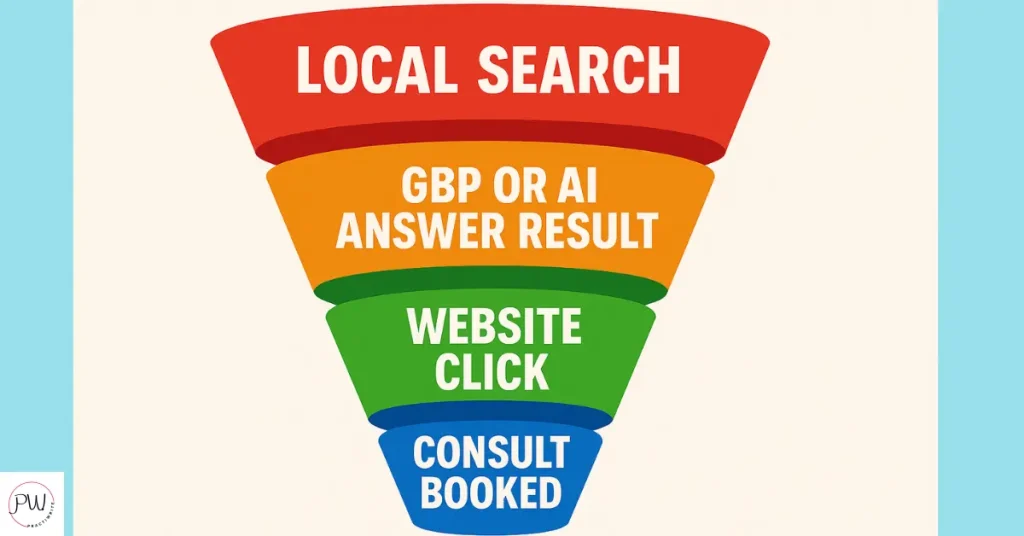
GEO vs. SEO: How AI Assistants Really Choose Your Practice
Let’s clear this up: GEO for dentists isn’t just a fancy rebrand of local SEO.
GEO = Generative Engine Optimization
It’s the strategy behind how AI assistants like Google’s SGE, ChatGPT, and Perplexity decide which local businesses to mention or cite in an AI-generated answer.
And if you’re still only focused on traditional SEO, like rankings, backlinks, and blogs, you’re going to miss how real patients are searching today.
Here’s the reality: AI assistants don’t “rank” pages like traditional search. They assemble answers. And they choose sources that are:
- Structured
- Consistent
- Backed by public proof
If you want your dental implant practice to get cited in that AI-generated answer box, you need to look like the authority, not just say you are.
What GEO Means for Your Practice (In Plain English)
If someone searches “does getting dental implants hurt” and your name shows up in the AI response, that’s GEO working.
It means the assistant found your content:
- Consistent across profiles
- Well-structured (schema helps)
- Matched to how real people ask questions
Google’s Search Generative Experience is now active for over 50% of US search queries and rapidly expanding into local business answers.
–Search Engine Journal, Aug 2024
Here’s How You Make AI Trust You
3 simple, practical tips to win AI’s trust:
1. Get Your Data Layer Right
Before you write a single word, make sure your practice looks solid in the code:
- Add LocalBusiness, Dentist, and MedicalProcedure schema to your implant pages.
- Mark up your doctor bios with Person schema (degrees, board certs, sameAs links to directories or social profiles).
- Keep NAP absolutely consistent across your footer, contact page, and GBP.
This isn’t optional. If your data’s a mess, AI skips you.
2. Write for Real Questions, Not Keywords
AI assistants pull from content that feels like a real answer to a real person.
Build an FAQ block with 8–12 clear, patient-first questions like:
- “Will I be able to chew normally after implants?”
- “What’s the downtime after All-on-4?”
- “Do I need a bone graft?”
Each answer should be 2–3 sentences, in plain English. Don’t write like a dentist, write like you’re explaining to a nervous patient.
Bonus points: Link out to a credible source when it helps. ADA, Mayo Clinic, etc.
3. Build “Public Proof” Everywhere
Assistants love corroboration; the same truth showing up in multiple places.
What that looks like:
- GBP fully filled out with current hours, photos, services
- Consistent service descriptions on your site and directories
- Fresh, real-sounding Google reviews (no generic “great visit” fluff)
- Embedded media (like videos or patient Q&A) with captions that match your FAQ language
According to Moz’s 2024 Local Ranking Factors, consistency, proximity, and review signals are the top 3 drivers of visibility in AI-enhanced local search.
Want a Fast Test?
Do this today:
- Pick one implant service page
- Add 3–5 FAQs in plain language
- Mark up with proper schema
- Make sure your NAP on that page matches your GBP exactly
- Add a short bio for the treating dentist with credentials
Then, in 2–3 weeks, check if you start showing up in AI-generated results or map mentions. You’re now testing GEO, not just SEO.
What If You’re Still Not Showing Up?
If 6 weeks go by and your name isn’t showing in results:
- Re-check your NAP data across all directories
- Make sure your reviews are recent (within the last 30 days)
- Adjust your FAQs to match how patients actually talk
- Validate your schema with Google’s Rich Results Test
This isn’t about perfection. It’s about clarity.
If your practice is sending mixed signals, AI can’t confidently include you. Fix the basics, then test again.
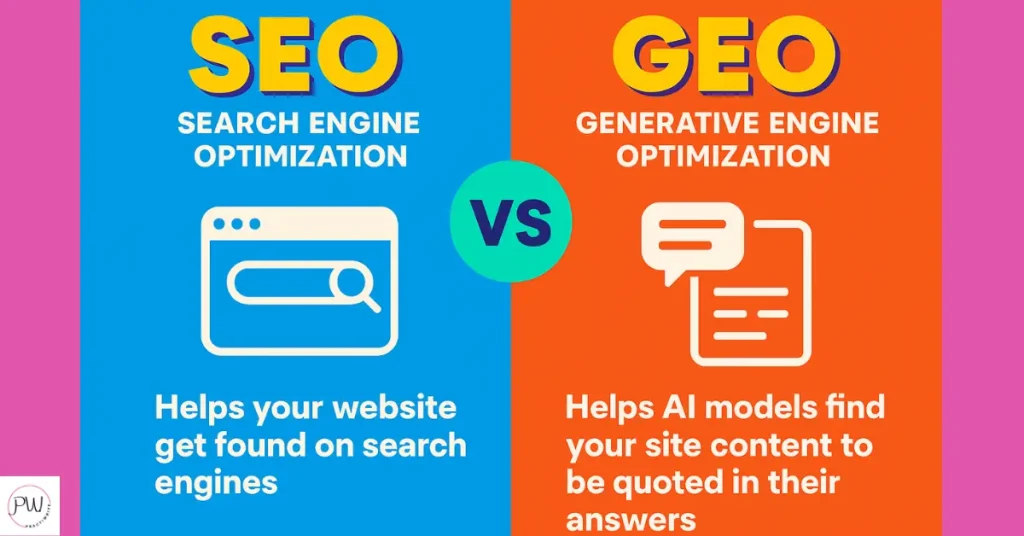
Final Takeaway: GEO Isn’t the Future. It’s Already Here.
And dental practices that get it right now are pulling ahead while others wait for “normal SEO” to kick in.
When a patient tells you, “I asked Google if implants were painful, and you were the one it mentioned,” you’ll know this works.
SEO/GEO Strategies for Dental Implant Practices: When to Use Traditional SEO vs. GEO for Local Growth
Here’s the truth no SEO agency wants to tell you (because it would cost them money): You don’t need 50 blog posts to get booked for dental implants.
If someone searches “how much are implants near me,” that’s a buying signal. If they search “what’s the difference between dentures and implants,” that’s research.
One is GEO. One is classic SEO. You need both, but not equally.
Use Classic SEO for Reach. Use GEO for Bookings.
Classic SEO is great for building evergreen authority. Think blog guides, educational content, and ranking for top-of-funnel questions like:
- “How do dental implants work?”
- “Implant vs. bridge pros and cons”
- “What are All-on-4 implants?”
That kind of content casts a wide net. It brings people to your site from all over—even outside your service area. Useful? Yes. But it doesn’t always convert.
Now compare that to GEO.
GEO earns you citations in AI answers, gets you in the Map Pack, and wins the “I’m ready to book now” searches.
Like:
- “dental implants near me”
- “all-on-4 same day [your city]”
- “emergency dental implant clinic open today”
That’s local intent. That’s where the money is.
The Practical Split (Use This to Guide Your Strategy)
Here’s how to split your energy and budget:
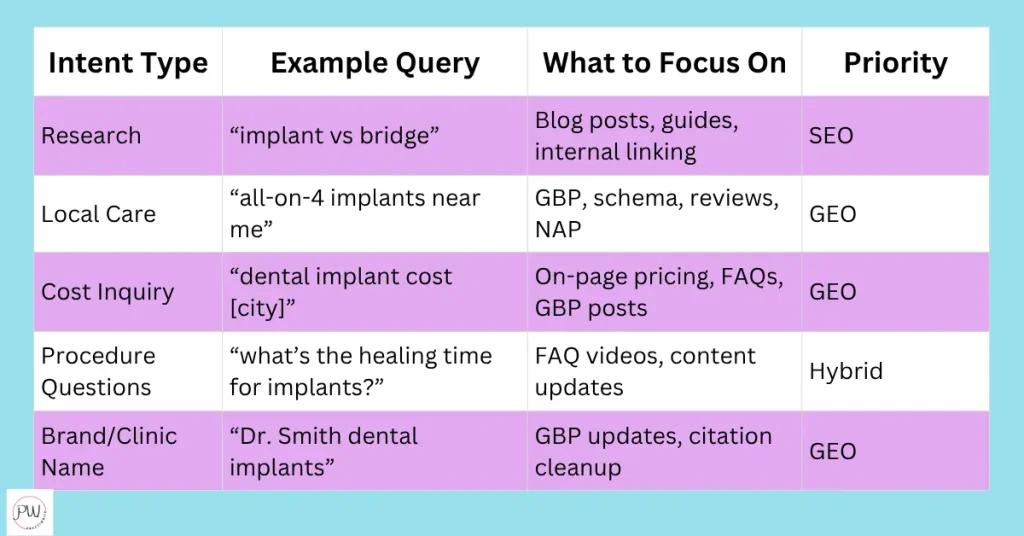
Quick win tip: Tag 30 recent queries in Google Search Console or your PPC platform as either research or care-ready based on if they include:
- “near me”
- your city or zip
- cost-related words (e.g. “price,” “financing”)
Then assign GEO work to the care-ready ones. That’s where you’ll see bookings come from.
Budgeting for Growth: What to Spend and When
Most dental practices burn money by over-investing in slow-moving blog content and under-investing in high-intent, local SEO fixes.
Use this as a general budget framework:
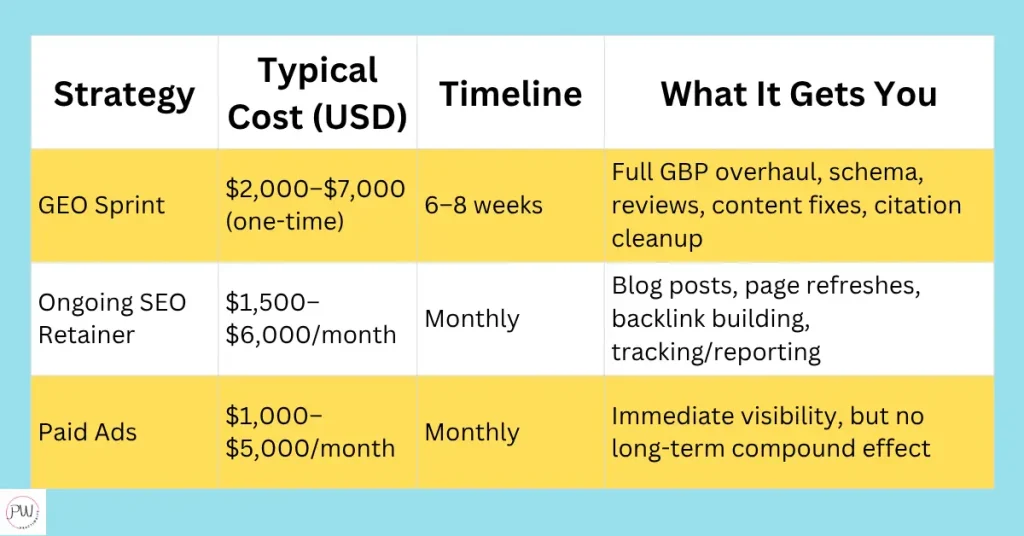
These numbers are based on my Practiwrite dental marketing agency averages and case data from over 400+ U.S. practices (2023–2025).
Smart strategy: Sprint your GEO work first. Get visibility + reviews rolling. Then layer in long-term SEO once local visibility is stable.
Real Example: How GEO Outperformed Ads in Phoenix
One of our partner practices in Phoenix ran a focused GEO sprint:
- Cleaned up NAP inconsistencies
- Added schema and rich FAQs
- Responded to every new review
- Published one GBP update weekly
Result: Within 7 weeks, they were cited in AI results for:
- “all-on-4 cost near me”
- “same-day dental implants Phoenix”
- “dental implants open Saturday”
And they didn’t spend a single dollar on ads.
Important Caveat: GEO Can’t Cover Bad Basics
GEO isn’t magic. It can’t help you if:
- Your service pages are thin
- You don’t have any real reviews
- Your credentials aren’t published
- You’re missing core services patients want (like sedation or financing)
You still need to serve what people are searching for. No amount of schema or local citations can cover for a broken funnel or poor UX.
Run the Hybrid Strategy That Actually Works
Here’s how to run both GEO and SEO without wasting time or budget:
Inputs:
- Pull top 30 search queries (from GSC or PPC)
- Tag each query as “research” or “care-ready”
- Prioritize GEO updates for care-ready
- Refresh blog content for research topics
Steps:
- Fix GBP completely
- Add pricing, FAQs, and schema to implant page
- Turn on HIPAA-safe review requests
- Post a weekly GBP update with a helpful tip, testimonial, or video
Check for success:
- You see Map Pack presence for local queries
- You’re being cited by AI assistants
- Calls and bookings increase for implant-related keywords
- Patients say, “You showed up when I searched for [X] near me”
Wrapping Up: Know What’s Working, and Keep It Moving
Remember that screenshot you took at 8:15 a.m., searching “dental implants near me”?
That’s not just a snapshot.
It’s your receipt. Your proof. Your scoreboard.
It shows you what Google (and AI) thinks about your practice right now.
Run that same search every week.
Same phone. Same query. Same route.
If nothing’s changed after 45–60 days of doing the right work, something’s still off.
Here’s what you should be seeing if your GEO and local SEO are actually working:
- Your name in the Map Pack
- Your GBP showing up in AI-generated answers
- More calls and direction requests from Google
- Patients saying “I found you when I asked Google about implants”
If you’ve made the updates and the needle’s moving, keep going.
If you’ve done the work and you’re still invisible, don’t wait around hoping the algorithm catches up.
If you’re a dental practice spending thousands on ads or waiting months for SEO to “kick in”… stop.
You don’t need more fluff, more theory, or another agency promising blog traffic that won’t convert.
You need GEO built the right way, now.
That’s exactly what we do inside Practiwrite:
- We don’t just write content. We build content that ranks, gets cited, and turns local searches into booked patients.
- We bring the tech, content, and local proof together so Google and AI trust your practice before the one down the street.
📲 Let’s get your practice found.
Book a no-obligation strategy session to get your Dental Practice Roadmap. See plainly how SEO/GEO will impact your practice.
You’ve already got the services. Let’s make sure your ideal patients can find them.
10+ year content strategist, writer, author, and SEO consultant. I work exclusively with dental practices that want to grow and dominate their local areas.
10+ year content strategist, writer, author, and SEO consultant. I work exclusively with dental practices that want to grow and dominate their local areas.
